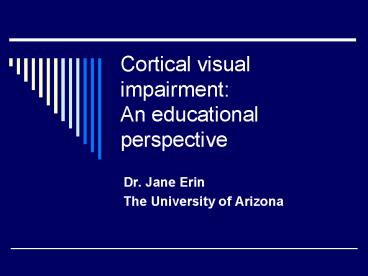Cortical visual impairment: An educational perspective - PowerPoint PPT Presentation
1 / 15
Title:
Cortical visual impairment: An educational perspective
Description:
CVI is a major cause of visual impairment among children ... Cortical visual impairment is one of three major causes of newly diagnosed ... – PowerPoint PPT presentation
Number of Views:800
Avg rating:3.0/5.0
Title: Cortical visual impairment: An educational perspective
1
Cortical visual impairmentAn educational
perspective
- Dr. Jane Erin
- The University of Arizona
2
CVI is a major cause of visual impairment among
children
- 21-22 of children with visual impairments in
U.S., New Zealand, and Australia have cortical
visual impairment (Kelley, Sanspree, and Davidson
(2000). - Cortical visual impairment is one of three major
causes of newly diagnosed visual impairments in
children, according to the Model Registry of
early childhood visual impairment (Hatton, 2001).
3
Common characteristics of CVI
- Fluctuating vision
- Reliance on peripheral vision
- Attentiveness to movement
- Preference for red and yellow
- Preference for familiar rather than novel
- Difficulty with cluttered backgrounds
- Glancing away and then toward
- Potential for improvement over time
- Visual latency
4
Physical development
- Strong prognosis for visual improvement within
first three years - Possibility of some improvement up to 7 years
- Some children diagnosed with Delayed Visual
Maturation regain functional vision - Effects of intervention (as compared to
maturation) are unknown
5
Cautions in interpreting the literature
- 1. Never and Always are not appropriate for
groups of students with CVI. These students show
wide individual variation, and they rarely show
all of the common characteristics.
6
2. Educational programming should not be based
on etiology
- Program decisions should be based on individual
assessment, including the functional vision
assessment. The diagnosis suggests global
characteristics that help determine assessment,
not specific interventions.
7
3. Compensatory approaches may be as important as
visual usage.
- Visual improvement may not result in integrated
use of senses. Students may respond more
immediately to information received through other
senses.
8
Physiological assessmentsGood, W., Jan, J.,
Burden, S., Sknezenski, A., Rowan, C. (2001)
- Computed tomography (CT) can show type and
location of damage. - Magnetic resonance imagery (MRI) is more
sensitive than CT scan. - Visual evoked response (VEP) maps responses over
a wider area and can be combined with an EEG
(Electroencephalogram) for diagnosis.
9
Formal assessments can document estimated acuity.
- Assessments based on gaze shift and visual
fixation can provide information about optimal
function under controlled conditions.
10
Assessment Scale The CVI Range
- Dr. Chris Roman, Marshall University, has
developed a rating scale that identifies - Characteristics of student
- Status of characteristics
- Levels 0-4 Building visual behaviors
- Levels 4-7 Embedding vision into function
- Levels 7-10 Resolution
11
Functional Vision Assessments
- Must be complete over several sessions, in
different settings and at different times of day. - Videotaping can be used to document initial
session and reassess vision at regular intervals. - Should involve familiar and unfamiliar objects
and settings. - Near and distance responses in central and
peripheral fields should be noted.
12
Strategies for intervention(Morgan, in Lueck,
2004)
- Do vision activities at time when best visual
function is observed. - Simplify the task.
- Slow the presentation and provide plenty of
response time before prompting. - Make sure expectations are evident.
- Provide structure and consistency.
- Space the target materials to allow visual
attention. - Reduce background clutter and sensory
information.
13
Environmental adaptations (Morgan, in Lueck,
2004)
- Control for glare
- Minimize florescent lighting
- Place student with back toward window
- Use indirect lighting
- Reduce irrelevant sensory information (e.g.,
background noise, odors) - Enhance visual targets with color, light
highlighting - Reduce visual detail
14
Provide multisensory cues and reinforcement,
according to childs preference (Morgan, in
Lueck, 2004)
- Add sound to the visual target.
- Create visual/tactile boundaries for task.
- Tap the childs arm or body on the side of an
approaching visual stimulus. - Encourage the student to track visual information
with a finger. - Use verbal cues for the beginning and ending of a
routine.
15
Key points
- Strategies can be useful with most students with
multiple disabilities. - Educational planning should be based on
assessment and observation, not diagnosis. - Consistent interventions with gradual
generalization will be most successful.































